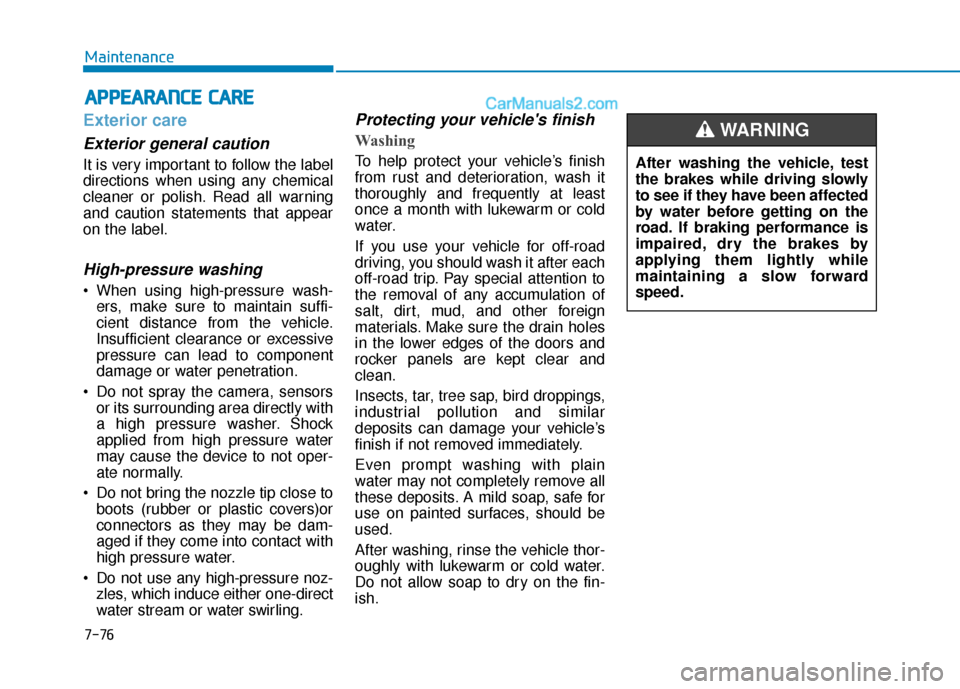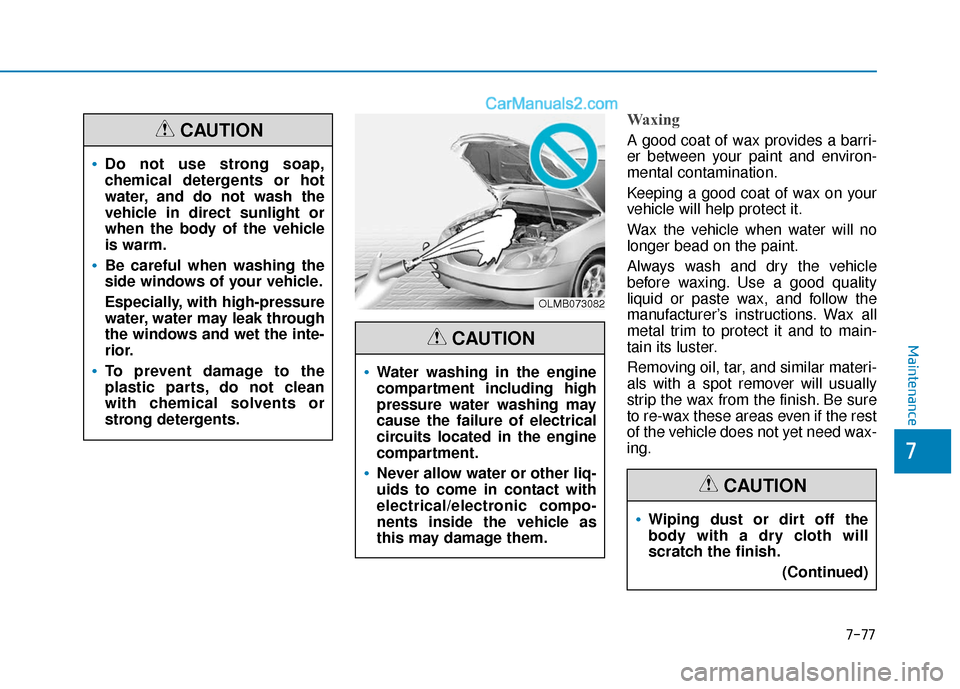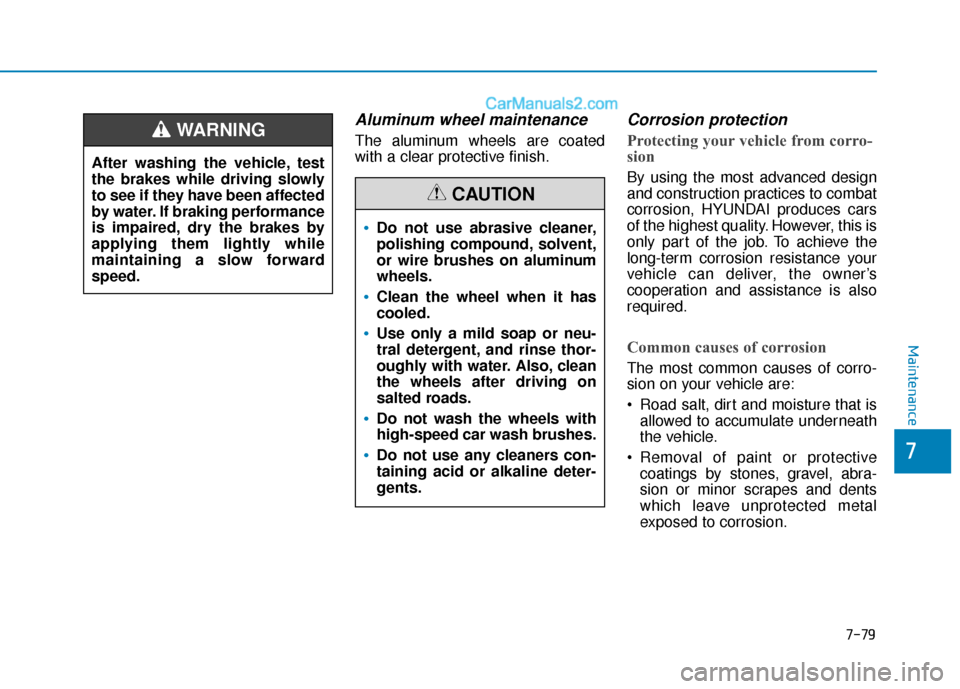2018 Hyundai Sonata Plug-in Hybrid light
[x] Cancel search: lightPage 471 of 552

7-76
Maintenance
A
AP
PP
PE
EA
A R
RA
A N
N C
CE
E
C
C A
A R
RE
E
Exterior care
Exterior general caution
It is very important to follow the label
directions when using any chemical
cleaner or polish. Read all warning
and caution statements that appear
on the label.
High-pressure washing
When using high-pressure wash-
ers, make sure to maintain suffi-
cient distance from the vehicle.
Insufficient clearance or excessive
pressure can lead to component
damage or water penetration.
Do not spray the camera, sensors or its surrounding area directly with
a high pressure washer. Shock
applied from high pressure water
may cause the device to not oper-
ate normally.
Do not bring the nozzle tip close to boots (rubber or plastic covers)or
connectors as they may be dam-
aged if they come into contact with
high pressure water.
Do not use any high-pressure noz- zles, which induce either one-direct
water stream or water swirling.
Protecting your vehicle's finish
Washing
To help protect your vehicle’s finish
from rust and deterioration, wash it
thoroughly and frequently at least
once a month with lukewarm or cold
water.
If you use your vehicle for off-road
driving, you should wash it after each
off-road trip. Pay special attention to
the removal of any accumulation of
salt, dirt, mud, and other foreign
materials. Make sure the drain holes
in the lower edges of the doors and
rocker panels are kept clear and
clean.
Insects, tar, tree sap, bird droppings,
industrial pollution and similar
deposits can damage your vehicle’s
finish if not removed immediately.
Even prompt washing with plain
water may not completely remove all
these deposits. A mild soap, safe for
use on painted surfaces, should be
used.
After washing, rinse the vehicle thor-
oughly with lukewarm or cold water.
Do not allow soap to dry on the fin-
ish. After washing the vehicle, test
the brakes while driving slowly
to see if they have been affected
by water before getting on the
road. If braking performance is
impaired, dry the brakes by
applying them lightly while
maintaining a slow forward
speed.
WARNING
Page 472 of 552

7-77
7
Maintenance
Waxing
A good coat of wax provides a barri-
er between your paint and environ-
mental contamination.
Keeping a good coat of wax on your
vehicle will help protect it.
Wax the vehicle when water will no
longer bead on the paint.
Always wash and dry the vehicle
before waxing. Use a good quality
liquid or paste wax, and follow the
manufacturer’s instructions. Wax all
metal trim to protect it and to main-
tain its luster.
Removing oil, tar, and similar materi-
als with a spot remover will usually
strip the wax from the finish. Be sure
to re-wax these areas even if the rest
of the vehicle does not yet need wax-
ing.
OLMB073082
Water washing in the engine
compartment including high
pressure water washing may
cause the failure of electrical
circuits located in the engine
compartment.
Never allow water or other liq-
uids to come in contact with
electrical/electronic compo-
nents inside the vehicle as
this may damage them.
CAUTION
Wiping dust or dirt off the
body with a dry cloth will
scratch the finish.(Continued)
CAUTION
Do not use strong soap,
chemical detergents or hot
water, and do not wash the
vehicle in direct sunlight or
when the body of the vehicle
is warm.
Be careful when washing the
side windows of your vehicle.
Especially, with high-pressure
water, water may leak through
the windows and wet the inte-
rior.
To prevent damage to the
plastic parts, do not clean
with chemical solvents or
strong detergents.
CAUTION
Page 474 of 552

7-79
7
Maintenance
Aluminum wheel maintenance
The aluminum wheels are coated
with a clear protective finish.
Corrosion protection
Protecting your vehicle from corro-
sion
By using the most advanced design
and construction practices to combat
corrosion, HYUNDAI produces cars
of the highest quality. However, this is
only part of the job. To achieve the
long-term corrosion resistance your
vehicle can deliver, the owner’s
cooperation and assistance is also
required.
Common causes of corrosion
The most common causes of corro-
sion on your vehicle are:
Road salt, dirt and moisture that isallowed to accumulate underneath
the vehicle.
coatings by stones, gravel, abra-
sion or minor scrapes and dents
which leave unprotected metal
exposed to corrosion.
After washing the vehicle, test
the brakes while driving slowly
to see if they have been affected
by water. If braking performance
is impaired, dry the brakes by
applying them lightly while
maintaining a slow forward
speed.
WARNING
Do not use abrasive cleaner,
polishing compound, solvent,
or wire brushes on aluminum
wheels.
Clean the wheel when it has
cooled.
Use only a mild soap or neu-
tral detergent, and rinse thor-
oughly with water. Also, clean
the wheels after driving on
salted roads.
Do not wash the wheels with
high-speed car wash brushes.
Do not use any cleaners con-
taining acid or alkaline deter-
gents.
CAUTION
Page 478 of 552

7-83
7
Maintenance
Caring for the leather seats- Vacuum the seat periodically toremove dust and sand on the seat.
It will prevent abrasion or damage
of the leather and maintain its qual-
ity.
- Wipe the natural leather seat cover often with dry or soft cloth.
- Use of proper leather protective may prevent abrasion of the cover
and helps maintain the color. Be
sure to read the instructions and
consult a specialist when using
leather coating or protective agent.
- Light colored (beige, cream beige) leather is easily contaminated and
the stain is noticeable. Clean the
seats frequently.
- Avoid wiping with wet cloth. It may cause the surface to crack. Cleaning the leather seats
- Remove all contaminationsinstantly. Refer to instructions
below for removal of each contam-
inant.
- Cosmetic products (sunscreen, foundation, etc.)
Apply cleansing cream on a cloth
and wipe the contaminate spot.
Wipe off the cream with a wet cloth
and remove water with a dry cloth.
- Beverages (coffee, soft drink, etc.) Apply a small amount of neutral
detergent and wipe until contami-
nations do not smear.
- Oil Remove oil instantly with
absorbable cloth and wipe with
stain remover used only for natural
leather.
- Chewing gum Harden the gum with ice and
remove gradually.Cleaning the seat belt webbing
Clean the belt webbing with any mild
soap solution recommended for
cleaning upholstery or carpet. Follow
the instructions provided with the
soap. Do not bleach or re-dye the
webbing because this may weaken
the seat belt.
Cleaning the interior windowglass
If the interior glass surfaces of the
vehicle become fogged (that is, cov-
ered with an oily, greasy or waxy
film), they should be cleaned with
glass cleaner. Follow the directions
on the glass cleaner container.
Do not scrape or scratch the
inside of the rear window. This
may result in damage to the rear
window defroster grid.
CAUTION
Page 479 of 552

7-84
Maintenance
E
EM
M I
IS
S S
SI
IO
O N
N
C
C O
O N
NT
TR
R O
O L
L
S
S Y
Y S
ST
T E
EM
M
The emission control system of your
vehicle is covered by a written limited
warranty. Please see the warranty
information contained in the Owner’s
Handbook & Warranty Information
booklet in your vehicle.
Your vehicle is equipped with an
emission control system to meet all
applicable emission regulations.
There are three emission control
systems, as follows.
(1) Crankcase emission control sys-
tem
(2) Evaporative emission control sys- tem
(3) Exhaust emission control system
In order to assure the proper function
of the emission control systems, it is
recommended that you have your
vehicle inspected and maintained by
an authorized HYUNDAI dealer in
accordance with the maintenance
schedule in this manual.1. Crankcase emission control system
The positive crankcase ventilation
system is employed to prevent air
pollution caused by blow-by gases
being emitted from the crankcase.
This system supplies fresh filtered air
to the crankcase through the air
intake hose. Inside the crankcase,
the fresh air mixes with blow-by
gases, which then pass through the
PCV valve into the induction system.
2. Evaporative emission controlsystem including onboard
refueling vapor recovery
(ORVR)
The Evaporative Emission Control
System is designed to prevent fuel
vapors from escaping into the atmos-
phere. The ORVR system is
designed to allow the vapors from
the fuel tank to be loaded into a can-
ister while refueling at the gas sta-
tion, preventing the escape of fuel
vapors into the atmosphere.
For the Inspection and
Maintenance Test (With
Electronic Stability Control
(ESC) system)
To prevent the vehicle from
ESC activation during
dynamometer testing, turn the
Electronic Stability Control
(ESC) system off by pressing
the ESC switch (ESC OFF
light illuminated).
After dynamometer testing is
completed, turn the ESC sys-
tem back on by pressing the
ESC switch again.
CAUTION
Page 486 of 552

B
BU
U L
LB
B
W
W A
AT
TT
TA
A G
G E
E
88
Specifications, Consumer information and Reporting safety defects
Light BulbBulb TypeWattage
Front
Headlamps
Low HB360
HighHB360
Low/HighLEDLED
Turn signal lampsFrontPY28/8W28
Outside rearview mirrorLEDLED
Position lampsLEDLED
Front side markerW5W5
Daytime running light (DRL)LEDLED
Rear
Rear combination lamp
Stop/Tail lampsBulb typeP28/8W28/8
Stop/Tail lampsLED typeLEDLED
Tail lampsP28/8W8
Turn signal lampsPY27W27
Back-up lampsW16W16
License plate lightW5W5
High mounted stop lampLEDLED
Interior
Map lampswith sunroofLEDLED
without sunroofFESTOON10
Room lampswith sunroofLEDLED
without sunroofFESTOON10
Luggage room lampFESTOON5
Glove box lampFESTOON5
Vanity mirror lampFESTOON5
8-3
Page 498 of 552

I-4
Driver assist system ......................................................3-119Rear parking assist system .......................................3-120
Rear parking assist system precautions....................3-123
Rear view camera .....................................................3-119
Driver attention alert system (DAA) ..............................5-63 Resetting the system ...................................................5-65
System malfunction ....................................................5-65
System setting and activation .....................................5-63
System standby...........................................................5-65
Driver position memory system .....................................3-14 Easy Access Function .................................................3-15
Storing Positions into Memory ..................................3-14
Driving the Hybrid/Plug-in Hybrid Vehicle ....................H22 Changing plug-in hybrid mode ...................................H26
Energy flow.................................................................H38
Hybrid system gauge ..................................................H24
Special features ...........................................................H23
Starting the vehicle .....................................................H22
Warning and indicator lights.......................................H27
Warning messages.......................................................H28 Emission control system .................................................7-84
Crankcase emission control system ...........................7-84
Evaporative emission control system including onboard refueling vapor recovery (ORVR) ............7-84
Exhaust emission control system ...............................7-85
Engine ........................................................................\
.......8-2
Engine compartment..................................................1-6, 7-3
Engine coolant/inverter coolant ......................................7-19 Changing engine coolant ............................................7-22
Checking the engine/inverter coolant level................7-19
Engine number ..................................................................8-9
Engine oil ........................................................................\
7-17 Checking the engine oil and filter ..............................7-18
Checking the engine oil level .....................................7-17
Engine Start/Stop button ...................................................5-5 Engine Stop/Start button positions ...............................5-7
Illuminated Engine Start/Stop button ...........................5-6
Starting the hybrid system............................................5-9
Explanation of scheduled maintenance items.................7-14
Exterior features..............................................................3-46 Fuel Filler Door (Hybrid) ...........................................3-53
Fuel Filler Door (Plug-in hybrid) ...............................3-56
Hood ........................................................................\
...3-46
Smart Trunk ................................................................3-50
Trunk ........................................................................\
..3-47
Index
E
Page 499 of 552

I-5
Exterior overview (I) ........................................................1-2
Exterior overview (II) .......................................................1-3
Fuses ........................................................................\
.......7-50Engine compartment panel fuse replacement ............7-52
Fuse/relay panel description .......................................7-54
Instrument panel fuse replacement.............................7-51
Hazard warning flasher .....................................................6-2
HEV (Hybrid electric vehicle) system ..............................H2 Hybrid Vehicle ..............................................................H2
Hybrid starter & generator (HSG) belt ...........................7-22 Checking the hybrid starter & generator (HSG) belt .7-22 If an accident occurs .......................................................6-34
If the engine overheats ......................................................6-7
If the vehicle will not start ................................................6-3
If the engine turns over normally but doesn't start ......6-3
If you have a flat tire ......................................................6-15 With tire mobility kit - Type A...................................6-15
With tire mobility kit - Type B...................................6-22
Important Safety Precautions............................................2-2 Air Bag Hazards ...........................................................2-2
Always Wear Your Seat Belt ........................................2-2
Control Your Speed ......................................................2-3
Driver Distraction.........................................................2-2
Keep Your Vehicle in Safe Condition ..........................2-3
Restrain All Children....................................................2-2
In case of an emergency while driving .............................6-2 If the vehicle stalls at a crossroad or crossing .............6-2
If the vehicle stalls while driving .................................6-2
If you have a flat tire while driving .............................6-3
Instrument cluster ...........................................................3-60 Gauges ........................................................................\
3-63
Instrument cluster control ..........................................3-62
Warning and indicator lights ......................................3-67
Warning messages ......................................................3-81
Instrument panel overview ...............................................1-5
I
Index
F
H
I